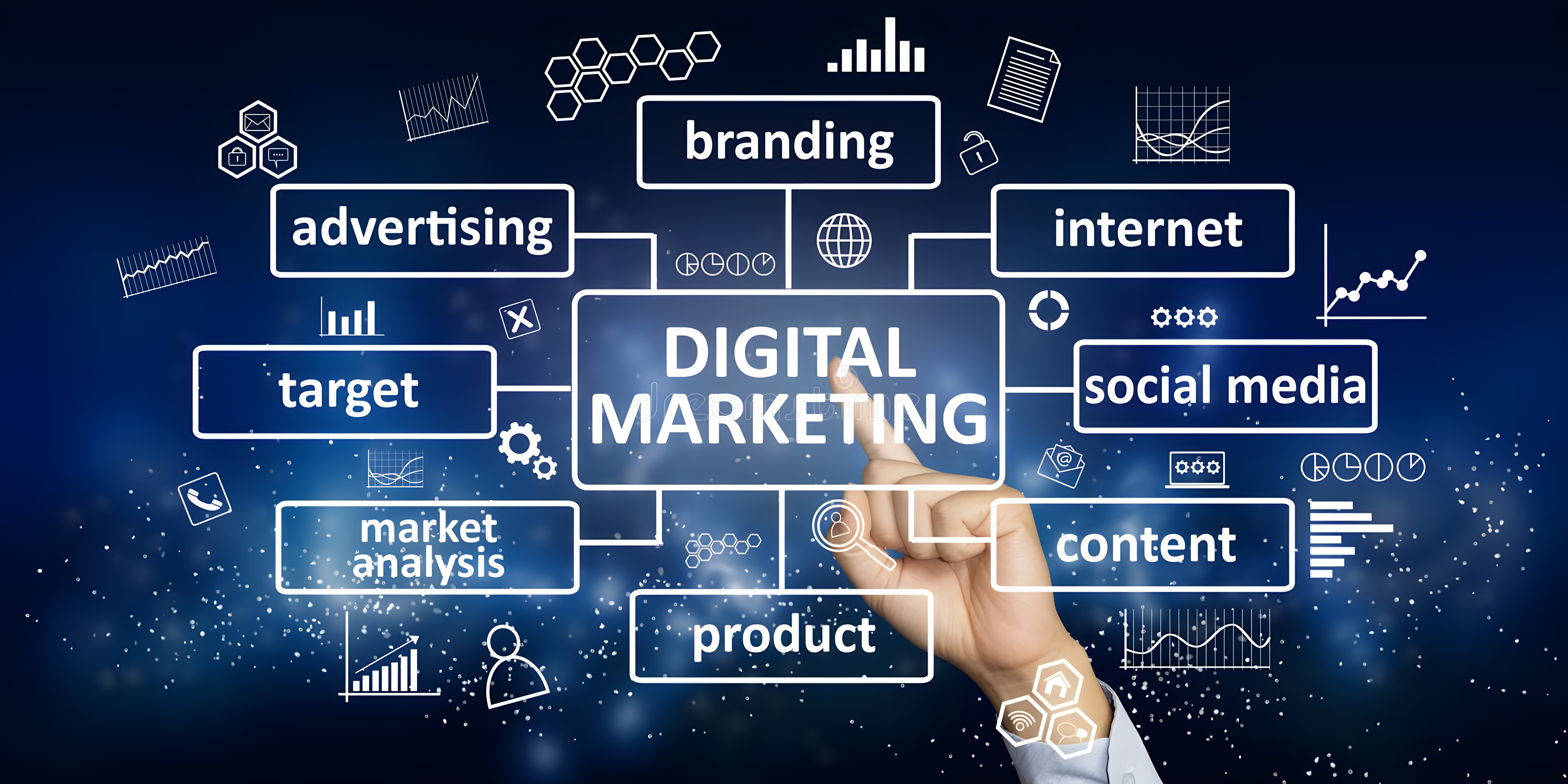Top 10 Benefits of Digital Marketing
Business Consultant, Digital Marketer & Author
Digital Marketing:
Digital marketing refers to the practice of promoting and advertising products, services, and brands using digital channels and technologies. It encompasses a wide range of activities aimed at reaching and engaging with target audiences through various digital mediums, such as websites, search engines, social media platforms, email marketing, mobile apps, and more.
Digital marketing leverages the internet and digital technologies to create, implement, and monitor marketing strategies. Its primary goal is to drive customer acquisition, increase brand awareness, and generate leads or sales through online channels. Unlike traditional marketing methods, digital marketing allows for precise targeting, personalized messaging, and measurable results.
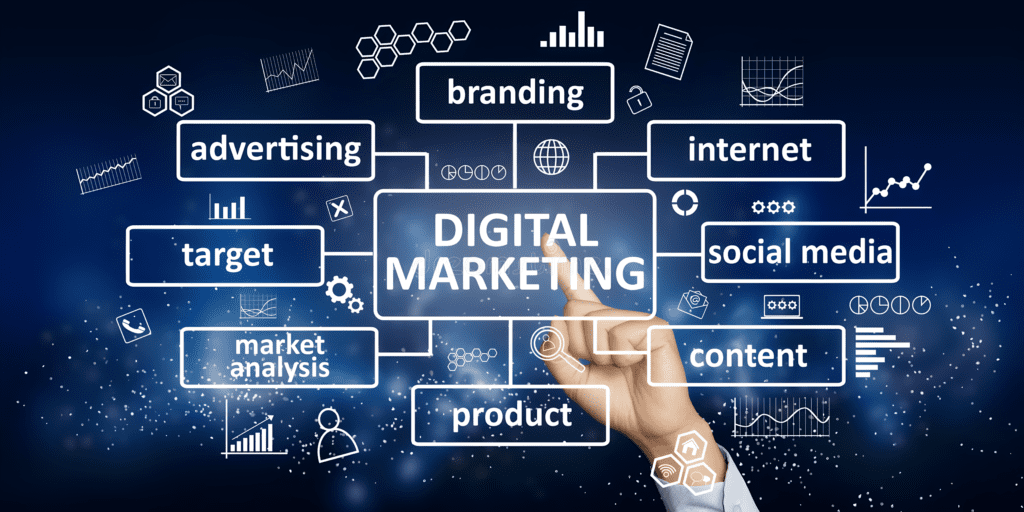
Difference between Traditional Marketing & Digital Marketing:
Traditional marketing and digital marketing differ in various aspects, including channels, reach, targeting capabilities, cost, measurement, and interactivity. Here are the key differences between the two:
- Channels: Traditional marketing primarily relies on offline channels such as television, radio, print media (newspapers, magazines), billboards, direct mail, and telemarketing. Digital marketing, on the other hand, utilizes online channels like websites, search engines, social media platforms, email, mobile apps, and online advertising networks.
- Reach: Traditional marketing often has a local or regional reach, although certain mediums like television and radio can have a broader reach. Digital marketing has a global reach, allowing businesses to target audiences worldwide.
- Targeting Capabilities: Traditional marketing has limited targeting capabilities, making it challenging to reach specific demographics. Digital marketing provides advanced targeting options based on factors like location, age, gender, interests, behavior, and more, allowing precise audience segmentation and personalized messaging.
- Cost: Traditional marketing methods can be costlier, especially for mediums like television advertising or print media, which require production and distribution expenses. Digital marketing offers cost-effective options, and businesses can set budgets according to their resources and objectives. Additionally, digital marketing allows for more flexibility in budget allocation and optimization.
- Measurement and Analytics: Traditional marketing often lacks precise measurement tools to gauge the effectiveness of campaigns. Digital marketing provides robust analytics platforms that enable businesses to track and measure various metrics in real time. These metrics include impressions, clicks, conversions, engagement rates, return on investment (ROI), and more, providing valuable insights for campaign optimization.
- Interactivity and Engagement: Traditional marketing is typically a one-way communication channel, where businesses convey their message to the audience without immediate interaction. Digital marketing allows for interactive and engaging experiences, such as social media interactions, comments, likes, shares, reviews, live chats, and personalized recommendations. This interactivity facilitates two-way communication between businesses and customers.
- Timing and Speed: Traditional marketing campaigns often require a longer lead time to plan, produce, and distribute content. Digital marketing enables businesses to launch campaigns quickly, make changes on the fly, and reach the audience instantly.
- Longevity: Traditional marketing materials, such as printed advertisements or TV commercials, have a limited lifespan. Once published or aired, they cannot be easily modified or updated. Digital marketing content can be modified and updated in real-time, allowing for more agile marketing strategies
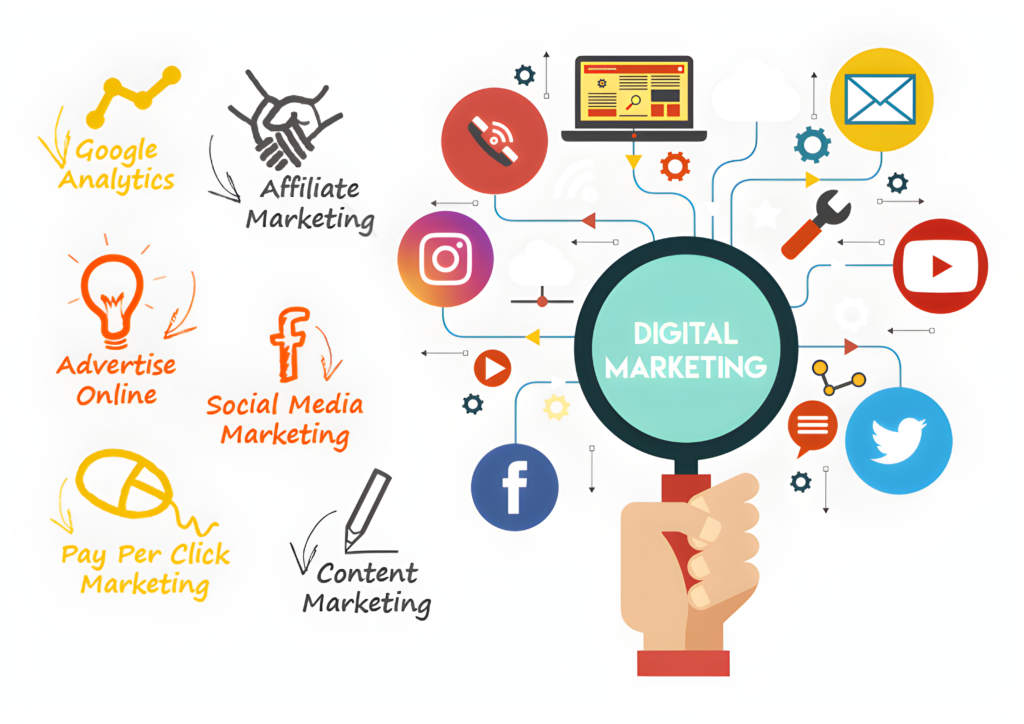
Types of Digital Marketing:
There are various types of digital marketing strategies and tactics that businesses can employ to promote their products, services, and brands. Here are some key types of digital marketing:
- Search Engine Optimization (SEO): SEO focuses on improving a website’s visibility in search engine results pages organically. It involves optimizing website content, meta tags, keywords, and technical aspects to rank higher in search engine rankings.
- Search Engine Marketing (SEM) and Pay-per-Click (PPC): SEM involves paid advertising on search engines. PPC is a specific form of SEM where businesses bid on keywords, and ads are displayed in search results. Advertisers only pay when their ad is clicked.
- Social Media Marketing: This type of marketing involves using social media platforms like Facebook, Twitter, Instagram, LinkedIn, and others to engage with audiences, build brand awareness, and promote products or services. It includes organic posting, paid advertising, influencer partnerships, and community management.
- Content Marketing: Content marketing focuses on creating and distributing valuable and relevant content, such as blog posts, articles, videos, infographics, podcasts, and e-books, to attract and engage target audiences. The goal is to provide value and build trust with potential customers.
- Email Marketing: Email marketing involves sending targeted emails to a list of subscribers to nurture leads, promote products or services, share news and updates, and build customer relationships. It can be used for lead generation, customer retention, and driving conversions.
- Affiliate Marketing: In affiliate marketing, businesses collaborate with affiliates or partners who promote their products or services on their own platforms. Affiliates receive a commission for each sale or lead they generate through their referral.
- Influencer Marketing: Influencer marketing involves partnering with influential individuals on social media who have a large following and credibility in a particular niche. Businesses collaborate with influencers to endorse their products or services and reach their engaged audience.
- Mobile Marketing: Mobile marketing focuses on targeting users on mobile devices. It includes mobile-friendly website design, mobile apps, SMS (text) marketing, push notifications, and location-based advertising.
- Display Advertising: Display advertising involves placing visual ads, such as banners, images, or videos, on websites, mobile apps, or advertising networks. Display ads can be targeted based on user demographics, behavior, or interests.
- Video Marketing: Video marketing utilizes videos to promote products, services, or brands. It can be done through platforms like YouTube, social media, or embedding videos on websites. Video content can include tutorials, product demos, testimonials, or storytelling.
- Remarketing/Retargeting: Remarketing involves targeting users who have previously visited a website or engaged with a brand but did not convert. Ads are displayed to these users on other websites or platforms to encourage them to return and complete a desired action.
- Native Advertising: Native advertising integrates promotional content seamlessly within the user experience of a platform. It matches the form and function of the platform on which it appears, making it less intrusive and more engaging.
- Online PR: Online PR focuses on utilizing online platforms to manage and enhance a brand’s public image. It involves activities such as press releases, online media coverage, reputation management, and crisis communication.
- Social Media Management: Social media management entails creating, scheduling, and managing content across various social media platforms. It involves engaging with the audience, responding to comments, monitoring brand mentions, and analyzing social media performance.
- Viral Marketing: Viral marketing aims to create and promote content that spreads rapidly and organically through social sharing. Memes, videos, or interactive campaigns are often used to evoke emotional responses or engage users in sharing content.
- Online Reputation Management (ORM): ORM involves monitoring and managing a brand’s online reputation through strategies that address negative reviews, comments, or feedback. It aims to maintain a positive brand image and customer perception.
- Podcast Marketing: Podcast marketing involves creating or sponsoring podcasts related to a specific industry or target audience. Businesses can either create their own podcasts or collaborate with established podcasters to reach and engage with their audience.
- Augmented Reality (AR) and Virtual Reality (VR) Marketing: AR and VR technologies provide immersive and interactive experiences for users. Brands can utilize AR and VR in marketing campaigns to showcase products, offer virtual tours, or create unique brand experiences.
- Chatbot Marketing: Chatbots are automated conversational agents that interact with users in real-time. Chatbot marketing involves using chatbots to provide customer support, answer queries, guide users through product selection, and collect customer data.
- Webinars and Online Events: Webinars and online events allow businesses to host virtual conferences, seminars, workshops, or product demonstrations. These interactive sessions help in educating and engaging the audience, generating leads, and building brand authority.
- User-Generated Content (UGC) Campaigns: UGC campaigns encourage users to create and share content related to a brand or its products. This content can be in the form of reviews, testimonials, social media posts, or contests. UGC campaigns help build social proof and engage the audience.
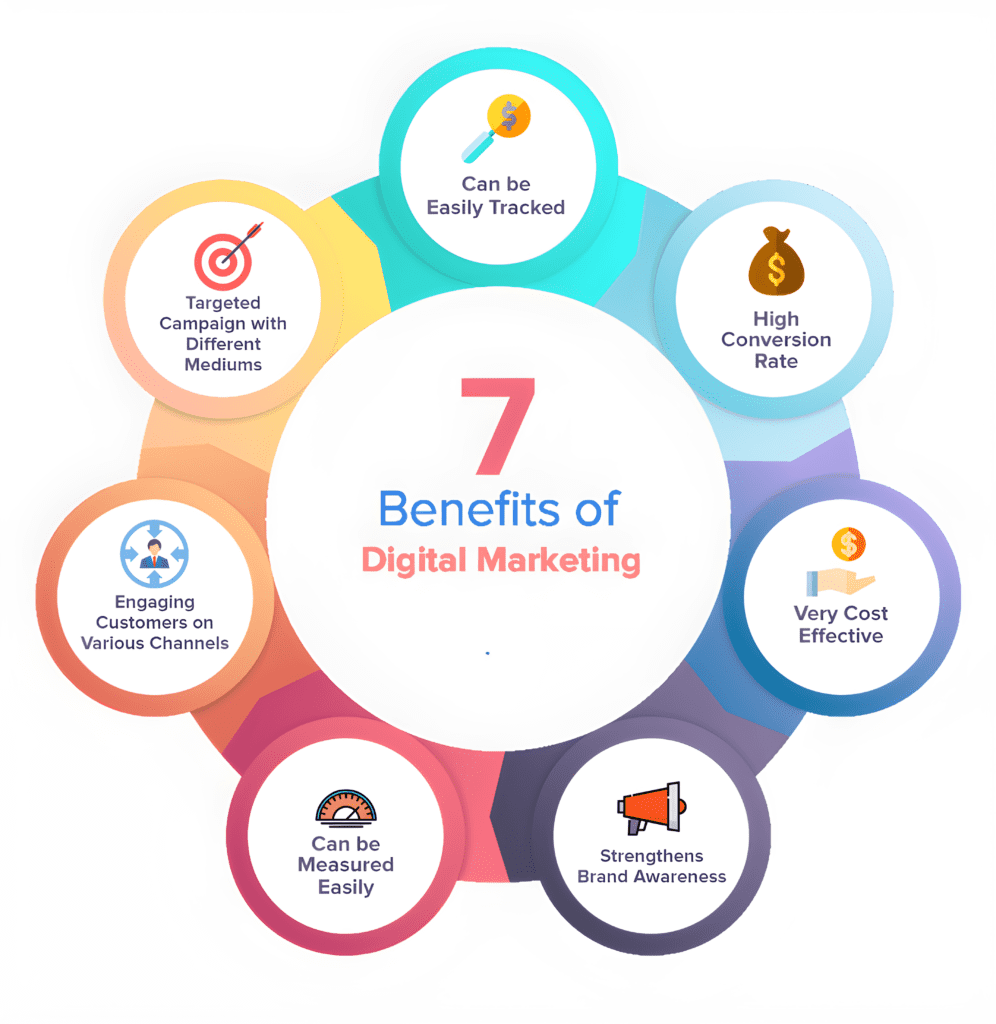
Top 10 Benefits of Digital Marketing:
Digital marketing offers numerous benefits to businesses of all sizes. Here are some key business benefits of digital marketing:
- Increased Reach: Digital marketing allows businesses to reach a global audience. With the internet and digital channels, you can expand your reach beyond geographical boundaries and target specific demographics or customer segments.
- Cost-Effectiveness: Compared to traditional marketing methods, digital marketing is often more cost-effective. Digital channels, such as social media and email marketing, offer affordable advertising options, and you can optimize your budget based on your goals and resources. Additionally, digital marketing allows for better tracking and measurement of ROI, enabling you to allocate your budget more efficiently.
- Targeted Audience: Digital marketing provides advanced targeting capabilities, allowing you to reach your ideal audience. You can target users based on demographics, interests, behavior, location, and more. This precise targeting ensures that your marketing efforts are focused on the right people, increasing the likelihood of engagement and conversions.
- Personalization and Customization: Digital marketing enables personalized and customized messaging. You can tailor your content and offers based on user preferences and behaviors, creating a more personalized experience for your audience. Personalization helps build stronger customer relationships and increases the chances of customer loyalty and repeat business.
- Measurable Results: One of the significant advantages of digital marketing is the ability to measure and track the performance of your campaigns in real time. You can use analytics tools to monitor key metrics such as website traffic, conversions, click-through rates, engagement, and more. This data provides valuable insights into the effectiveness of your marketing efforts, allowing you to make data-driven decisions and optimize your strategies for better results.
- Flexibility and Agility: Digital marketing offers flexibility and agility in campaign execution. You can make changes to your campaigns on the fly, test different strategies, adjust messaging or targeting, and quickly adapt to market trends or customer needs. This agility allows businesses to respond promptly to changing market dynamics and stay ahead of the competition.
- Brand Development and Awareness: Digital marketing helps businesses build their brand presence and increase brand awareness. By consistently engaging with your audience through various digital channels, you can reinforce your brand messaging, values, and unique selling propositions. This creates brand recognition and helps establish trust and credibility among your target audience.
- Enhanced Customer Engagement: Digital marketing facilitates two-way communication and engagement with customers. Through social media, email marketing, live chats, and interactive content, you can actively interact with your audience, address their queries, provide personalized recommendations, and gather feedback. Increased customer engagement leads to stronger relationships, customer loyalty, and advocacy.
- Competitive Edge: Digital marketing allows businesses of all sizes to compete on a level playing field. Even with limited resources, you can leverage digital channels to reach and engage with your target audience effectively. By implementing innovative digital marketing strategies, you can differentiate your business, stand out from competitors, and gain a competitive edge.
- Improved Conversion Rates: Digital marketing tactics, such as personalized messaging, targeted advertising, and optimized user experiences, can lead to improved conversion rates. By delivering the right message to the right audience at the right time, you increase the likelihood of conversions, whether it’s making a purchase, filling out a form, or subscribing to a service.
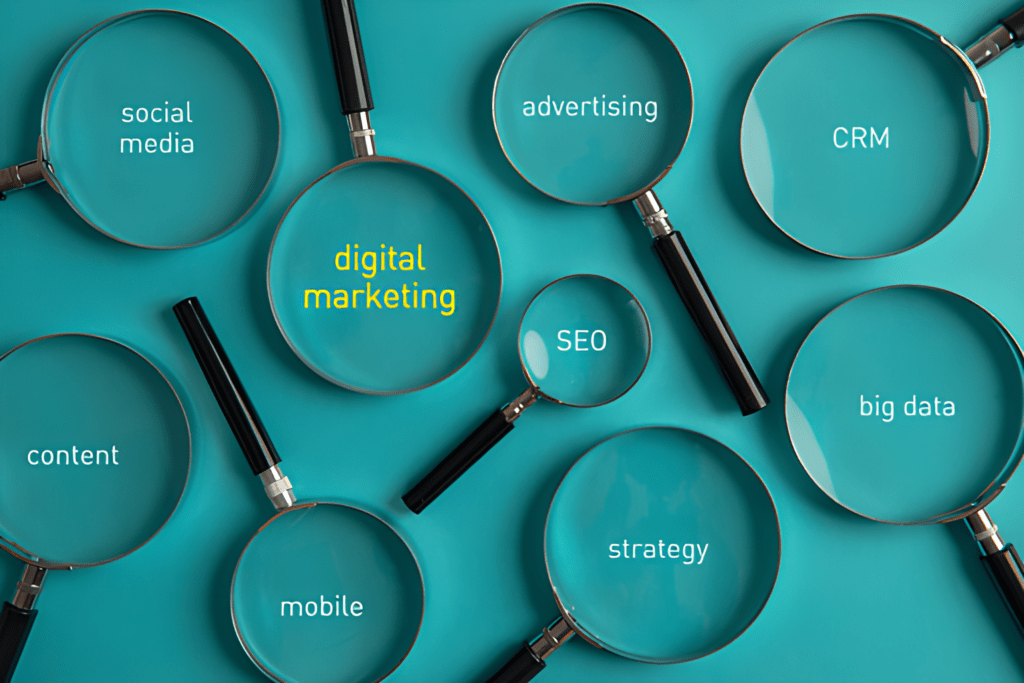
Finally; we can state that, a skilled digital marketer can help your company to leverage digital channels effectively, reach the target audience, drive engagement and conversions, and achieve business growth in the dynamic and competitive digital landscape.
Developing Bangladesh Bangladesh Trade Center To know more, click here!


